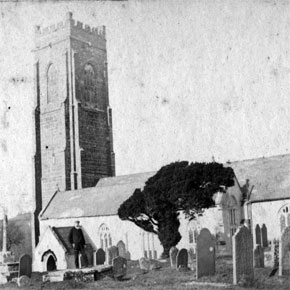Watchet's Heritage - St. Decuman's Church

St Decuman's Church is one of the finest and largest in the district and was awarded a Grade I listing in 1950. In style, it is principally perpendicular with the exception of the chancel which is 12th century and the earliest part of the Church.
The Church was substantially enlarged in the 13th century with a central tower and again in the 15th century when the tower was rebuilt at the west end of the Church in its current position and the north aisle added.
The Church was given to the diocese of Wells in 1190 by the Britto family on land owned by the FitzUrse family - these two families seeking to find favour with the Church and King Henry, following the murder of Beckett by their sons Reginald FitzUrse and Richard Britto in 1170.
There is much to interest the visitor inside the church, the principal place of Christian worship since the thirteenth century. Historical records at Wells say that there was formerly a minster chapel, which was lost to the sea. It contained the tomb of St Decuman and the date of its removal to the new church was celebrated as a feast day for many years. However another site is suggested at Cleeve Hill on an area occupied by the 'Old Minster Field' - a name in use since the mid eighteenth century at least and recent evidence has given this theory credence with aerial photographs giving an outline of a large building following the shape of a Minster.
There is no question on entering that you will experience a great sense of its history as this is, without doubt, a special place imbued with a great sense of distant history and spirituality. Taking time to sit awhile in contemplation, it is interesting to speculate on the countless generations of Watchet folk who have occupied the pews in one form or another over the centuries.
Looking upwards at the wagon roofs, your gaze will be arrested by the early carved medieval angels, not just wonderful ornamentation but signifying the instruments of the passion to give a visual representation, not unlike medieval wall paintings. The decorative bosses are also of interest as each individual carving is unique.
Near the south door is the 15th-century font and on the wall is a list of Vicars dating back to 1310. (In Wells Cathedral, they list St Decuman's Vicars back to 1245). An unusual feature of this list is that the name of the reigning monarch is shown beside each vicar's name.
Of particular interest on the northern aisle, the pillars accommodate canopied niches containing carved figures of Saints, Angels and Doctors of the Church. Try not to miss the two finely-carved figures of St George and St Anthony on a pillar behind the pulpit.
The somewhat restored rood screen is particularly impressive and there is an area at the base which reveals some clearly visible medieval (red) painted carving. You cannot fail to be impressed by the encaustic tiles on the chancel floor, probably dating from as early as the 13th century with their origins from nearby Cleeve Abbey. It is indeed incredible to think that for 700 years these tiles have survived and witnessed the footsteps of untold numbers of worshipers and visitors over the centuries.
In the chancel, it's worth noting the oldest window in the church with the crest of Edward 1, dated 1245; also the excellent 17th-century carved altar rail. You can also find evidence of the original 12th-century doorway (also visible from outside).
There are a good deal of impressive memorials dedicated to the Wyndham family who were long-term patrons of the Church since the 15th century and Kentsford, a little distance past St Decuman's Well in the valley below, was for a time the family seat. There is a leaflet in the Church that will explain these fascinating memorials, some of which are made from local alabaster from the cliffs here at Watchet. At the time the family occupied Kentsford, there is a visual reminder by means of an unusual depiction of Sir John and Lady Florence Wyndham. On the east wall, a big black slab of Tournai marble depicts Sir John and Lady Florence in brass relief. Bills confirm it was made in London by Nicholas Stone, 1634-7. This is of considerable interest as Stone was the favourite sculptor of King Charles First and his work is as highly regarded now as it was then.
There is much more to interest the visitor, not least the 15th-century porch with its original oak door and also the medieval preaching cross, the 17th century carved wooden pulpit with its fine cartouche design carved in the canopy above, the organ, built by Osmond of Taunton in 1923 was fully restored in 2014 and, importantly, the six bells of which the oldest dates from 1440.
The old and newer cemeteries contain 18 graves of those who died in WW1 and WW2, details of which can be found in a free CWGC booklet available in the Church porch and graveyard gate. The Church holds many treasures, more than can be included on this code and is open most days during the hours of daylight. You will find an informative guidebook also available.
For further information about the town as a whole,
please visit the home page or click
Here
This page is provided by Watchet Conservation Society with the help of Watchet Chamber of Trade
and with funding from Somerset West & Taunton Council's High Street Emergency Fund.
Text and history provided by Nick Cotton
